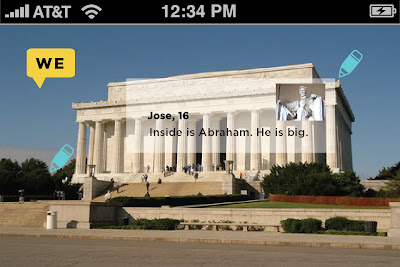Thursday, December 15, 2011
Thursday, November 17, 2011
Monday, October 31, 2011
[karen] phase3
Karen[Phase3]





Monday, October 17, 2011
Sunday, October 16, 2011
Ivanhoe Brandmarks and Signatures: Four Quadrants

Friday, October 14, 2011
Ipad and Iphone
iPad Presentation
Sunday, October 9, 2011
3D Modeling & Design Direction

Ray and I decided to create a model that reflected the news feed that the user of our community can tailored and set in his settings, allowing him to just have a newsfeed of the users that he selects from the particular rooms. An ESL high school student in our community will be mainly interacting with 4 groups: the students in his online class room, friends, experience ESL students that have experienced and share their knowledge with these students whom don't know much about the language or the customs. The last group they interact will be the ESL teachers, that will help them acquire the knowledge for them to compete with mainstream students.
Friday, October 7, 2011
Wednesday, October 5, 2011
Tuesday, October 4, 2011
[karen]"phase2final"
The existing brand is called Wines by Jennifer, a wine boutique located in Parkville, Missouri. That provides customers with a unique wine tasting experience, allowing their clients to test wines from different regions of the world. This boutique is located in a house, which its relaxed environment allows for testers to feel like they were just at home. The rebranding of this establishment will involve renaming it to make it more accessible and up-to date, focusing the branding to have a younger audience to visit the establishment. The goal of my design is to convey a sense of modernity and a fresh approach to the act of wine tasting. The identity will speak to a younger audience with a credible, flexible and progressive attitude. Making wine tasting a fun and welcoming experience.
The three directions from my rebrand are 405 PEAK, Bottle Shock and Nutty & Roasted.
The one that I feel best represents my design objective is 405 PEAK, this brandmark is modern, fun, credible and friendly.





Friday, September 30, 2011
Ivanhoe Update
Tuesday, September 27, 2011
Tuesday, September 20, 2011
Reading Response: He Might Be Giant, Guerrilla Street Postering: Civil Disobedience in Los Angeles, Adbuster: Veronique Vienne Interviews Kalle Lasn
Monday, September 19, 2011
Friday, September 16, 2011
Next-to-last ESL High School Students Poster
Solutions and Needs
Monday, September 12, 2011
Response to Readings: Towards Critical Autonomy, The Designeras Catalyst, Beyond Literal Materiality, Now That We Can Do Anything, What Will We Do?
It talks about type style and and only those who are trained to see changes in the type style or formatting. Most style choices are made to please the eye, make a text legible and presentable or produce an "aesthetic" design. There are graphic instances that have graphical codes that affect our reading and we make connections of a time or era. Interestingly, the article talks about how in early twentieth century journals were style to appeal different audience. Unbroken columns of text were aimed for a masculine sensibility while the broken up of chunks and graphics aimed at a female reader. The desktop user has the possibilities in treating various type settings and therefore many graphical components assume their own "entity", is what the author calls "literal materiality" that a graphical entity is simply "there" and thus available to a rich, descriptive discussion of its self-evident characteristics. Characters depending on it's use (position, juxtaposition and context) it has a different effect. For example hand-lead text the shifting it up and down, weight can all be factors of placement, juxtaposition, leading and surrounding space.
Offline needs & online solutions
Needs
1. Relationships with peers ( make friends outside of their ESL class)
2. Better understanding of the new country
3. Help applying for colleges and/ or scholarships
4. Eliminate Stereotypes (want to be understood)
5. Learn subjects & English at an equal level like mainstream students
Wednesday, September 7, 2011
Wines by Jennifer Phase 1




[Karen]Phase1
Monday, September 5, 2011
Response to Readings: The Birth of the user, Graphic Authorship, The Designer as a Producer
Thursday, September 1, 2011
Recognizable Issues at Ivanhoe
One Stop Career Centers in Missouri are managed by the Division of Workforce Development of the Department of Economic Development. In conjunction with employment and training organizations, the centers strive to meet the specific needs in each local community. They are equipped with computers, fax machines and telephones. Individual services include skills assessment, career exploration, job placement, job training, family support services and mental health services. Those eligible include basic skills deficient individuals, dislocated workers, people with criminal records, low-income individuals, eligible youth and those seeking non-traditional employment. MissouriCareerSource is the ....development! is the online service that focuses on providing services related to employment, training, job and workforce development.
Contact:
Division of Workforce Development
Missouri Department of Economic Development
421 E. Dunklin St.
P.O. Box 1087
Jefferson City, MO 65102
573-751-3999
573-751-4088 fax
Family & Parenting Support Group 816.932.2258
































